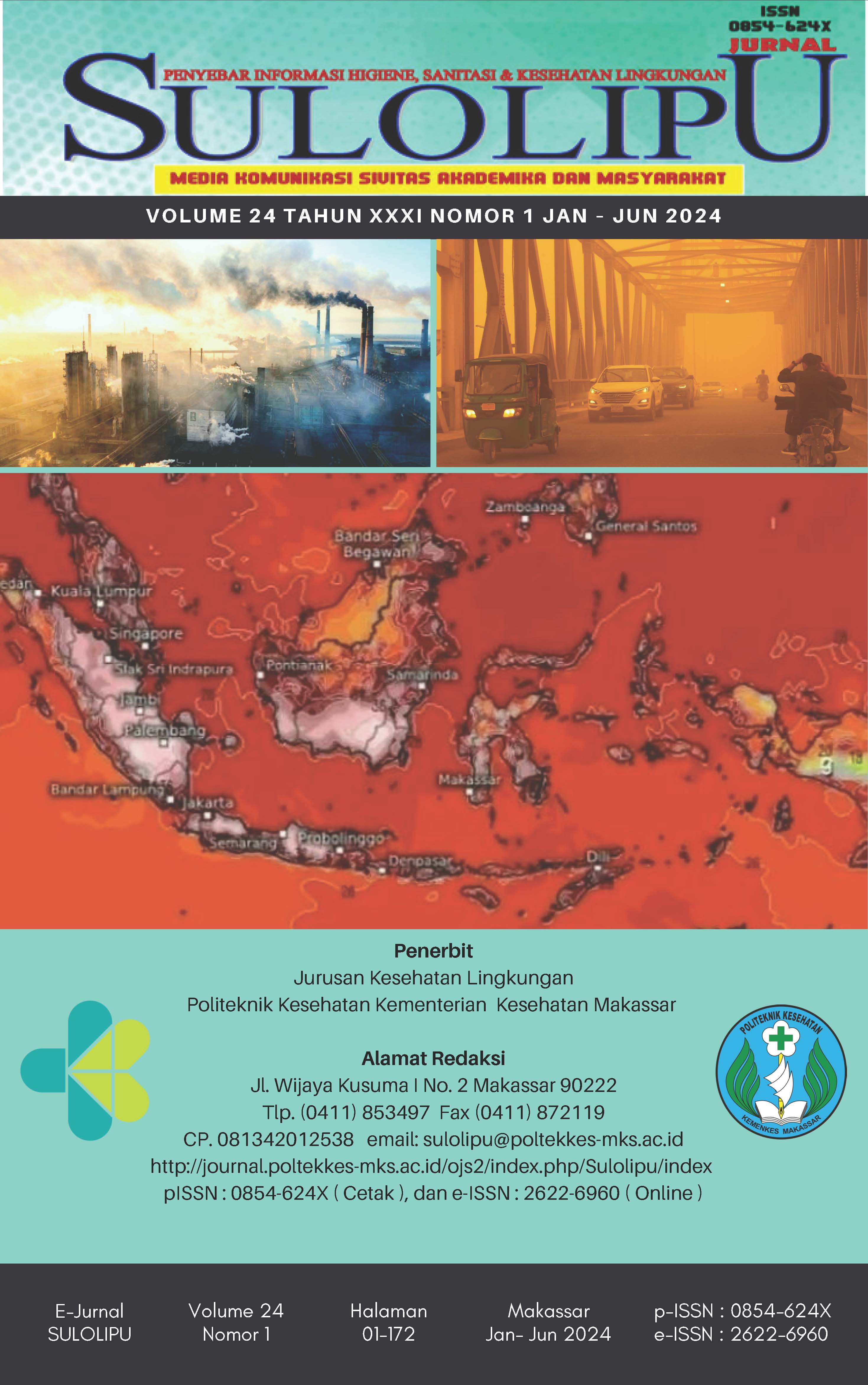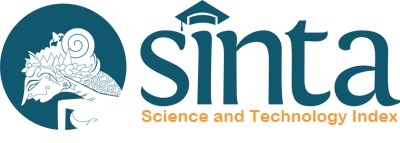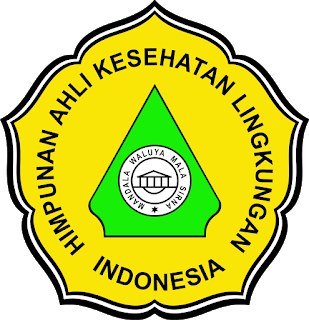Relationship between Environmental Conditions and the Presence of Aedes Mosquito Eggs in the Working Area of the Bontokassi Health Center, Takalar Regency
DOI:
https://doi.org/10.32382/sulo.v24i1.467Keywords:
Aedes aegepty; Ovitrap, Demam BerdarahAbstract
The mosquitoes Aedes aegypti and Aedes albopictus are vectors of dangue hemorrhagie fever, having unique habitat and behavior characteristics. The Aedes aegypti and Aedes albopictus mosquitoes can generally be found in settlements, people’s homes and buildings. One of the ways can be used to determine the existence of Aedes aegypti mosquitoes in one district is conducting a survey and installing an ovitrap.The study aims to know the relationship between temperature, humidity, lighting conditions and environmental cleanliness with the density of Aedes mosquito eggs in Bontokassi Public Health Center, Galesong Selatan District, Takalar Regency. This type of this research is Analytical Observational with a cross-sectional study design. The results show that the presence of Aedes mosquito eggs in the working area of the bontokassi public health center has an average of 67,3% inside the house and 55,8% outside the house. There is no relationship between indoor air temperatures and outdoor air temperature, is no relationship air humidity, there is a relationship lighting conditions, and there is a relationship between the cleanliness of the outside environment and the existence of Aedes mosquito eggs Bontokassi Public Health Center. In a conclusion, There are 3 categories of variables which have no relationship and 4 variable category which has a relationship with the density of Aedes mosquito eggs in Bontokassi Public Health Center. The researcher suggested for all community to keep the home environment clean.
Keywords : Aedes aegepty; Ovitrap, Dengue Fever
References
Agustina, Elsi, Nurlidza Razma Rizha Purwanda, Dan E. (2020). Sebaran Nyamuk Aedes Di Kampus Uin Ar-Raniry Banda Aceh Pada Masa Pandemi Covid-19. 17–21.
Agustina, N., Abdullah, A., & Arianto, E. (2019). Hubungan Kondisi Lingkungan dengan Keberadaan Jentik Aedes aegypti di Daerah Endemis DBD di Kota Banjarbaru. Balaba: Jurnal Litbang Pengendalian Penyakit Bersumber Binatang Banjarnegara, 171–178. (Online) https://doi.org/10.22435/blb.v15i2.1592
Astuti, P., & Lustiyati, E. D. (2018). Hubungan Kondisi Lingkungan Fisik Terhadap Tingkat Kepadatan Larva Aedes Sp Di Sekolah Dasar Wilayah Kecamatan Kasihan, Bantul, Di Yogyakarta. Jurnal Ilmu Kesehatan Masyarakat, 9(3), 216–225. (Online) Https://Doi.Org/10.26553/Jikm.V9i3.314
Darwamati, L. P., & Sukesi, T. W. (2021). Pengaruh Warna Ovitrap Terhadap Jumlah Telur Nyamuk Aedes aegypti. Jurnal Kesehatan Dan Pengelolaan Lingkungan, 2(2), 152–156. (Online). https://doi.org/10.12928/jkpl.v2i2.6350
Dewangga, V. S., Qurrohman, M. T., Tamba, N. P. D., Tika, Vera, Pratiwi, A. D. M. G., & Indah, K. (2022). Edukasi Manfaat Lilin Kayu Manis Sebagai Anti Nyamuk Di Kelurahan Pucang Sawit. 04(01), 1–6.
Fitria, R. (2021). Hubungan Faktor Lingkungan Fisik Dan Tindakan Masyarakat Dengan Kejadian Demam Berdarah Dengue Di Wilayah Kerja Puskesmas Sering. UIN Sumatra Utara.
Hikmawa, I., & Huda, S. (2021). Peran Nyamuk Sebagai Vektor Demam Berdarah Dengue (Dbd) Melalui Transovarial (1st ed.).Satria Publisher, Jawa Tengah, 25-36.
Lestari, A. P. D., Handayani, D., Prasasty, G. D., Dalilah, D., & Pariyana, P. (2022). Perbedaan Daya Tetas Telur Nyamuk Aedes Aegypti Pada Tiga Jenis Air Perindukan. Syifa’ MEDIKA: Jurnal Kedokteran Dan Kesehatan, 12(2), 165.(Online. https://doi.org/10.32502/sm.v12i2.4003
Mardiana. (2016). Pengaruh Penggunaan Ovitrap Terhadap Indeks Kepadatan Larva Aedes Aegypti (House Index, Container Index, Breteau Index) Di Wilayah Kelurahan Harapan Baru Kecamatan Loa Janan Ilir Kota Samarinda (1st ed.).Muhammadiya Samarinda Sekolah Tinggi Ilmu Kesehatan Program Studi Ilmu Kesehatan Masyarakat, Samarinda, 16-21.
Mawardi, M., & Busra, R. (2019). Studi Perbandingan Jenis Sumber Air Terhadap Daya Tarik Nyamuk Aedes aegypti Untuk Bertelur. Jurnal Serambi Engineering, 4(2), 593–602. https://doi.org/10.32672/jse.v4i2.1444
Mutakin, A. (2018). Apa Lingkungan Itu? Geoarea, 1(2), 65–68.(Online). https://ejurnal.unibba.ac.id/index.php/Geoarea/article/download/147/151/557
Satoto, T. B. T., Pascawati, N. A., Diptyanusa, A., Lazuardi, L., Dwiputro, A. H., & Nugroho, A. (2021). Fluktuasi Demam Berdarah Dengue Terkait Variabilitas Cuaca Di Klaten, Indonesia. Vektora : Jurnal Vektor Dan Reservoir Penyakit, 13(1), 45–60. (Online). https://doi.org/10.22435/vk.v13i1.4333
Suryowati, K., Bekti, R. D., & Faradila, A. (2018). Analisis Spasial Efektivitas Fogging Di Wilayah Kerja Puskesmas Makroman, Kota Samarinda. IOP Conference Series: Materials Science and Engineering, 335(1), 1–7.(Online). https://doi.org/10.1088/1757-899X/335/1/012052
Downloads
Published
How to Cite
Issue
Section
PDF (Bahasa Indonesia) downloaded: 998



















